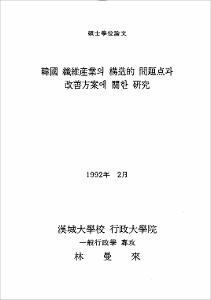韓國 纖維産業의 構造的 問題點과 改善方案에 關한 硏究
= Study on systematic problems of textile industry in Korea and its alternatives for improvement
- Type
- Thesis
- Department
- 일반행정전공
- Issued Date
- 1992
- Publisher
- 漢城大學校 行政大學院
- Keyword
- 섬유산업; 섬유산업구조조정; Textile industry
- Files in This Item:
-
-
Download
 000000066314.pdf
기타 데이터 / 2.72 MB / Adobe PDF
000000066314.pdf
기타 데이터 / 2.72 MB / Adobe PDF
-
Items in Repository are protected by copyright, with all rights reserved, unless otherwise indicated.